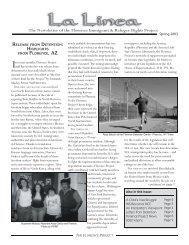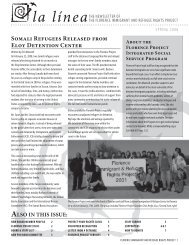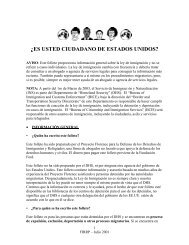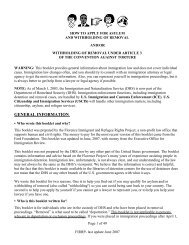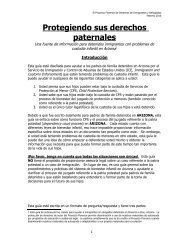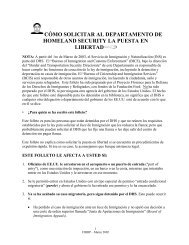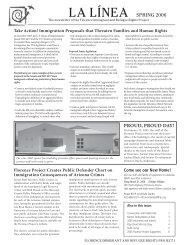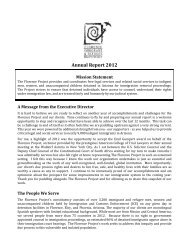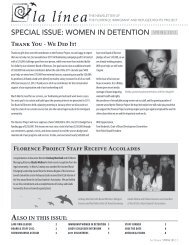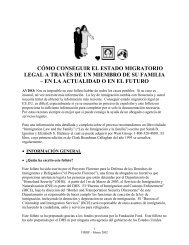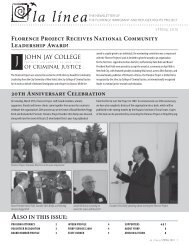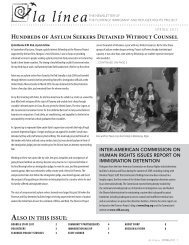quick reference chart and annotations for determining immigration ...
quick reference chart and annotations for determining immigration ...
quick reference chart and annotations for determining immigration ...
Create successful ePaper yourself
Turn your PDF publications into a flip-book with our unique Google optimized e-Paper software.
Immigrant Legal Resource Center, Florence Immigrant <strong>and</strong> Refugee Rights Project,<br />
Maricopa County Public Defender August 2012<br />
owners would surprise the burglar <strong>and</strong> violence would ensue. United States v. Becker, 919 F.2d 568, 573<br />
(9th Cir. 1990). The Fifth Circuit applied this same theory to criminal trespass <strong>and</strong> found it to be a crime<br />
of violence. See U.S. v. Delgado-Enriquez, 188 F.3d 592, 595 (5th Cir. 1999). Leave record vague<br />
between A1/A5 <strong>and</strong> A6, since A6 may present a weaker case.<br />
Crime Involving Moral Turpitude (CMT): Divisible. The BIA has held that entry of an<br />
occupied dwelling with intent to commit any offense is a CMT. Matter of Louissaint, 24 I&N Dec. 754<br />
(BIA 2009). However, <strong>immigration</strong> counsel can argue that A1 is not a CMT if the record fails to show<br />
that the dwelling was occupied or that there was an intent to commit an offense therein. Mere unlawful<br />
entry under A2, <strong>and</strong> probably A3, is not a CMT. A4 <strong>and</strong> A5 are probably CMTs. Leave record open to<br />
possibility of A2.<br />
Also, if the record of conviction or even police reports or other documents indicate that the<br />
person intended to commit larceny or another offense that is a CIMT, ICE may assert that it can use this<br />
in<strong>for</strong>mation to find that the offense is a CIMT. While <strong>immigration</strong> counsel will rightly argue that intent<br />
to commit a further crime is neither an element of trespass, nor a fact that would be necessary to prove an<br />
element of trespass in a particular case, the <strong>immigration</strong> judge might wrongly hold <strong>for</strong> the government.<br />
31. Possession of Burglary Tools, ARS § 13-1505<br />
A. A person commits possession of burglary tools by:<br />
1. Possessing any explosive, tool, instrument or other article adapted or commonly used <strong>for</strong> committing<br />
any <strong>for</strong>m of burglary as defined in sections 13-1506, 13-1507 <strong>and</strong> 13-1508 <strong>and</strong> intending to use or permit<br />
the use of such an item in the commission of a burglary.<br />
2. Buying, selling, transferring, possessing or using a motor vehicle manipulation key or master key….<br />
C. Possession of burglary tools is a class 6 felony.<br />
Crime Involving Moral Turpitude (CMT): This is a divisible statute. Counsel should keep the<br />
record of conviction clear of evidence of defendant’s intent to use the tools to commit a particular kind of<br />
burglary: one where the offense to be committed upon entry involves moral turpitude, such as theft. In<br />
other words, counsel either should not permit the record of conviction to describe the intended burglary,<br />
or should phrase the intent in a vague manner such as “theft or any felony” or “a felony.” However, as a<br />
practical matter many <strong>immigration</strong> judges are categorically finding this to be a CMT.<br />
A1. The issue is the intent within the burglary the person intends to commit. Burglary under 13-<br />
1506, 13-1507, <strong>and</strong> 13-1508 may not be a CMT if the record of conviction establishes that the client is<br />
guilty of “theft or any felony” or “a felony.” Matter of S-, 6 I&N Dec. 769 (BIA 1955) (possession of<br />
burglary tools with intent to commit any offense is not a CMT unless accompanied by an intent to use the<br />
tools to commit a specific crime which is itself a CMT). It is a CMT if the record of conviction or other<br />
evidence establishes that the intent is to commit theft or another CMT. (To determine whether an offense<br />
may be found turpitudinous in <strong>immigration</strong> court, see Matter of Silva-Trevino, 24 I&N Dec. 687 (A.G.<br />
2008).) This may also be found a CMT if the burglary was of an occupied dwelling, regardless of<br />
whether the underlying intent involved theft. Matter of Louissaint, 24 I&N Dec. 754 (BIA 2009)<br />
A2. This should not be a CMT since there is no element in this section requiring an intent to<br />
commit a CMT. See Matter of S-, id. However, in practice, some <strong>immigration</strong> judges may find it to be a<br />
CMT.<br />
Arizona Criminal Chart with Explanatory Endnote – August 2012<br />
44



